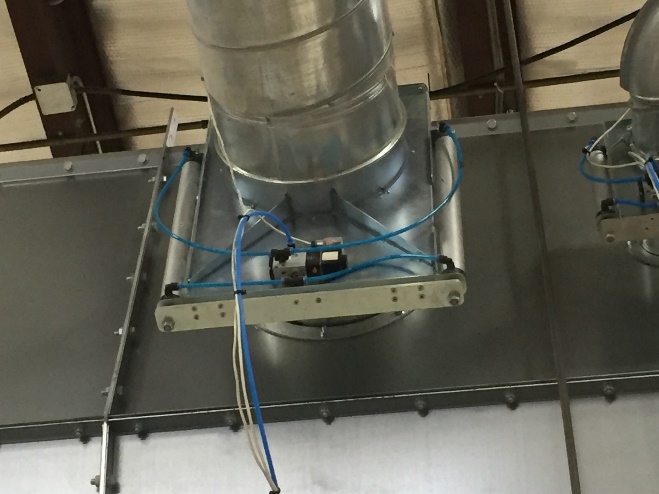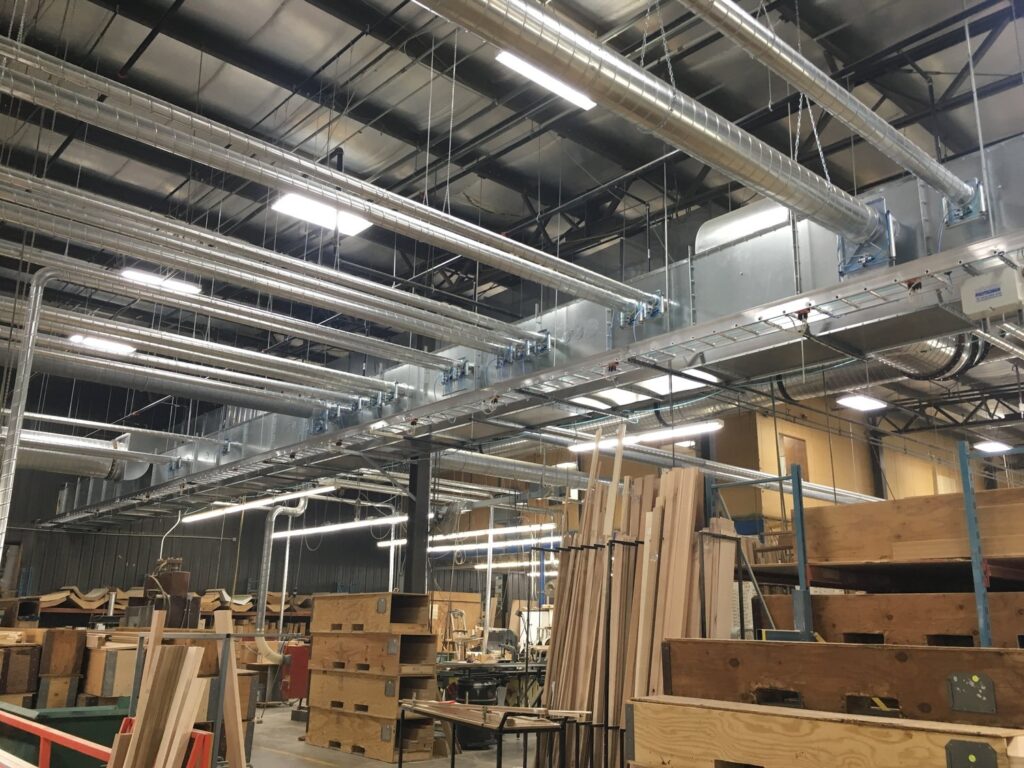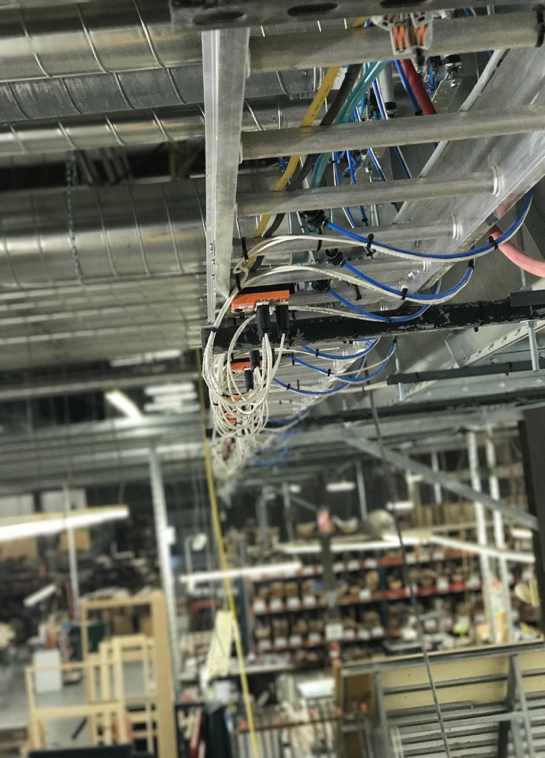0%
Reduction in Energy Costs0+
Kiowatt Hour Reduction in Energy Consumption per Year$0
Energy Efficiency Rebate from Connexus EnergyAbout
Crystal Cabinet Works Inc. is a family-owned, custom cabinet manufacturer based in Central Minnesota. Producing quality products since 1947, they sell cabinetry through independent kitchen and bath dealers across the US and Canada. With 450 employees, their team works from 6 a.m. – 3 p.m. five days a week, with a skeleton crew on the second shift. Their single manufacturing location, consisting of a 270,00 square foot plant, is located in Princeton, Minnesota.
Products
– Höcker MultiStar dust collection 30x6 with airlock and conveyor duct inside building
Facing Down Production Bottlenecks
Struggling with an antiquated dust collection system, the team at Crystal Cabinet Works Inc. (CCW) wanted to find an alternative to their more than 35-year-old system that was essentially a hodgepodge of parts from four different companies.
“Basically, as our production grew and our dust collection needs grew, we added accordingly,” said Jared Nierengarten, Maintenance Manager at Crystal Cabinet Works.
The dust collection system as it previously stood steadily became less efficient. It was leaking and devouring energy with a combined 650 horsepower (hp). Additionally, the immovability of the system created major obstacles any time equipment was added to the plant or needed to be moved around.
“We faced everything from capacity issues to OSHA standards changing over the years, but capacity was probably the biggest one. We needed to get higher air velocities and it wasn’t possible with the old systems,” said Greg Rask, Manufacturing Engineer at Crystal Cabinet Works.
Escalating issues with dust collection eventually hindered other improvement projects from taking place. Reaching a breaking point, the team at CCW began to look for a new system that was both updated and efficient.
“We found it very difficult to reorganize certain areas of the plant based on how the dust collection was set up. The flexibility was very minimal. We decided to look for a system that allowed us unlimited flexibility. Ideally we wanted something that could be rerouted and reconnected with little effort.
– Jared Nierengarten, Maintenance Manager, Crystal Cabinet Works
Searching for a Solution
CCW’s search for a better and more technologically advanced dust collection system led them to Höcker North America where they commissioned a pair of dust collection systems.
Finding one company to do it all
The first big surprise for the team at CCW when they began searching for a better dust collection solution was that they didn’t have to piecemeal a system together.
“The whole blast gate system was something that we knew about but it always required using two or three vendors to get it all to work,” shared Nierengarten. “So when we found Höcker, we found the one company that could do it all. That’s when we started getting interested in the whole system.”
Comparing designs from a variety of vendors, many failed to provide added benefits to make the costs worthwhile. “With Höcker we could see a payback,” said Rask.
A first in North America
Once working with Höcker North America began, a unique design began to evolve. CCW’s system would be a first in the country to have each of the dust collectors incorporating a unique conveyor to streamline dust collection hookups to individual machines. Additionally, each machine would have its own dedicated blast gate that would only open when the machine was in operation.
These features, combined with other efficiencies from the Höcker system itself, dramatically reduced energy consumption. CCW received a $71,000 energy efficient rebate from Connexus Energy once the Höcker systems were up and running.
“We were always looking for these types of savings but I always viewed dust collection as a necessary evil,” said Nierengarten. “We were very pleased to see the words ‘energy management system’ tied to anything that had to do with dust collection.
“Höcker’s conveyor system, though new to us, was a no-brainer. It’s a very simple concept. When a piece of equipment generates dust, it gets sucked into the chain conveyor where it loses its velocity due the conveyor’s chamber being larger than the dust pipe. The larger particles settle to the bottom and get conveyed and scraped into a centralized airlock.”
– Jared Nierengarten, Maintenance Manager, Crystal Cabinet Works
Implementing Change
To address the layout of their plant, CCW installed two separate dust collection systems — one on the north side and one on the south. This ensured systems were available for the two production sections spread out across the 27,000 square foot plant.
If they were laid end to end, the duct pipes of the two new dust collection systems would extend “well over two miles,” said Nierengarten.
Each of the 150 pieces of equipment across the plant had its own dedicated duct piping and blast gate. These connected perpendicularly to the overhead dust chain conveyor system running from one end to the other of each production department which were set up on either side of the finishing department.
On the north side, the Höcker dust collector has eight independent 50-hp motors. While it is capable of achieving a total airflow velocity of more than 120,000 cubic feet per minute (CFM), it is rare that enough blast gates are open to require more than half of the motors’ output at any time.
On the south side, the dust collector has three 30-hp motors and a capacity of just over 30,000 CFM.
“We have practically changed out every piece of pipe in this plant,” said Rask. “We had to. One of the principles of going to hooking one pipe per piece of equipment is that you go from a lot of larger diameter pipes to smaller diameter pipes. We used to have pipes that were 36 inches round. Now I think our biggest is 20 inches.”
Working efficiently, both of the dust collector systems carry the fine particles away to the collector’s filter, which now holds more waste since large particulates don’t reunite with the smaller ones until they reach an exterior silo. “Typically every Wednesday four 40-yard dumpsters of sawdust get hauled away for use as animal bedding,” said Nierengarten.

“Even if you don’t take Höcker’s Energy Management into consideration, Crystal Cabinets would still see a 25 percent reduction in energy costs just from our higher efficiency fans and motors.”
– Ben Dipzinski, Owner at Höcker North America
Seeing the Benefits
Plug and Play Flexibility
One of the most significant benefits to the new conveyor system was how dramatically they simplified machine movement in the plant. No longer confined by the dust collection system they previously had, each machine has its own piping and blast gate. All the team now has to do to move a machine is unhook the ductwork from the conveyor and plug it in somewhere else.
“With all the equipment now connected individually, we simply move, add or delete a piece or pieces and seal up the old connections or cut in a new one. We no longer have to reengineer the system,” said Nierengarten.
Adding to the flexibility of the system, each machine in the CCW plant has a unique IP address that ties into the Höcker dust collector’s CAN bus system via a network cable that runs alongside the conveyor. After a machine is moved, the first time it’s turned on, Höcker’s main computer knows immediately where that machine has been moved to and its CFM needs.
This enhanced flexibility has opened up the potential for the CCW team to implement other improvement projects.
“Now, we’ll be able to plan process improvement projects with the proper air flow already in place rather than trying to plan that flow in accordance with how it would best work around our dust collection,” said Nierengarten.
Less Juice, More Savings
Another big change was evident when both Nierengarten and Rask looked at power output.
“With our old system, we turned on 650 horsepower at 5:30 in the morning and we wouldn’t turn it off until 3:30 or 4:00 in the afternoon,” said Rask. “The system would run all the way through all 150 pieces of equipment during that entire time.”
Now, only the dust collection air velocity for the machines that are on gets used. “The dust collector has the capability of ramping up or down based on how many blast gates are open,” said Rask.
According to Connexus Energy, CCW now uses an estimated one million kilowatt hours less in energy each year. Energy savings like these are equivalent to meeting the electricity needs of 94 average US households and reduces the company’s carbon footprint by over 1.2 million pounds of carbon dioxide.
A Healthier, Safer Work Environment
A cleaner work environment has been an unexpected benefit of the new dust collection systems.
“We’re starting to realize how much plant cleanliness has improved,” said Rask. “When operators start blowing off their machines before going home, we don’t see the haze like we used to.”
The new systems are in compliance with the NFPA 652 combustible dust rule and are regularly cleaned to prevent combustible dust buildup.

“We’re starting to realize how much plant cleanliness has improved. When operators start blowing off their machines before going home, we don’t see the haze like we used to.”
– Greg Rask, Manufacturing Engineer, Crystal Cabinet Works

Better Efficiencies, Better Dust Collection
The ripple effect of the enhanced efficiency created by their new Höcker dust collection systems didn’t go unnoticed. Even those at CCW who weren’t involved in the design and installation noted a difference.
“The efficiencies of the new system have not gone unnoticed by fellow employees,” said Nierengarten. “I’ve heard the word, “Wow!” and one operator told me, ‘I’ve got some really good dust collection for a change.’”
Facing Down Production Bottlenecks
Struggling with an antiquated dust collection system, the team at Crystal Cabinet Works Inc. (CCW) wanted to find an alternative to their more than 35-year-old system that was essentially a hodgepodge of parts from four different companies.
“Basically, as our production grew and our dust collection needs grew, we added accordingly,” said Jared Nierengarten, Maintenance Manager at Crystal Cabinet Works.
The dust collection system as it previously stood steadily became less efficient. It was leaking and devouring energy with a combined 650 horsepower (hp). Additionally, the immovability of the system created major obstacles any time equipment was added to the plant or needed to be moved around.
“We faced everything from capacity issues to OSHA standards changing over the years, but capacity was probably the biggest one. We needed to get higher air velocities and it wasn’t possible with the old systems,” said Greg Rask, Manufacturing Engineer at Crystal Cabinet Works.
Escalating issues with dust collection eventually hindered other improvement projects from taking place. Reaching a breaking point, the team at CCW began to look for a new system that was both updated and efficient.
“We found it very difficult to reorganize certain areas of the plant based on how the dust collection was set up. The flexibility was very minimal. We decided to look for a system that allowed us unlimited flexibility. Ideally we wanted something that could be rerouted and reconnected with little effort.
– Jared Nierengarten, Maintenance Manager, Crystal Cabinet Works
Searching for a Solution
CCW’s search for a better and more technologically advanced dust collection system led them to Höcker North America where they commissioned a pair of dust collection systems.
Finding one company to do it all
The first big surprise for the team at CCW when they began searching for a better dust collection solution was that they didn’t have to piecemeal a system together.
“The whole blast gate system was something that we knew about but it always required using two or three vendors to get it all to work,” shared Nierengarten. “So when we found Höcker, we found the one company that could do it all. That’s when we started getting interested in the whole system.”
Comparing designs from a variety of vendors, many failed to provide added benefits to make the costs worthwhile. “With Höcker we could see a payback,” said Rask.
A first in North America
Once working with Höcker North America began, a unique design began to evolve. CCW’s system would be a first in the country to have each of the dust collectors incorporating a unique conveyor to streamline dust collection hookups to individual machines. Additionally, each machine would have its own dedicated blast gate that would only open when the machine was in operation.
These features, combined with other efficiencies from the Höcker system itself, dramatically reduced energy consumption. CCW received a $71,000 energy efficient rebate from Connexus Energy once the Höcker systems were up and running.
“We were always looking for these types of savings but I always viewed dust collection as a necessary evil,” said Nierengarten. “We were very pleased to see the words ‘energy management system’ tied to anything that had to do with dust collection.
“Höcker’s conveyor system, though new to us, was a no-brainer. It’s a very simple concept. When a piece of equipment generates dust, it gets sucked into the chain conveyor where it loses its velocity due the conveyor’s chamber being larger than the dust pipe. The larger particles settle to the bottom and get conveyed and scraped into a centralized airlock.”
– Jared Nierengarten, Maintenance Manager, Crystal Cabinet Works
Implementing Change
To address the layout of their plant, CCW installed two separate dust collection systems — one on the north side and one on the south. This ensured systems were available for the two production sections spread out across the 27,000 square foot plant.
If they were laid end to end, the duct pipes of the two new dust collection systems would extend “well over two miles,” said Nierengarten.
Each of the 150 pieces of equipment across the plant had its own dedicated duct piping and blast gate. These connected perpendicularly to the overhead dust chain conveyor system running from one end to the other of each production department which were set up on either side of the finishing department.
On the north side, the Höcker dust collector has eight independent 50-hp motors. While it is capable of achieving a total airflow velocity of more than 120,000 cubic feet per minute (CFM), it is rare that enough blast gates are open to require more than half of the motors’ output at any time.
On the south side, the dust collector has three 30-hp motors and a capacity of just over 30,000 CFM.
“We have practically changed out every piece of pipe in this plant,” said Rask. “We had to. One of the principles of going to hooking one pipe per piece of equipment is that you go from a lot of larger diameter pipes to smaller diameter pipes. We used to have pipes that were 36 inches round. Now I think our biggest is 20 inches.”
Working efficiently, both of the dust collector systems carry the fine particles away to the collector’s filter, which now holds more waste since large particulates don’t reunite with the smaller ones until they reach an exterior silo. “Typically every Wednesday four 40-yard dumpsters of sawdust get hauled away for use as animal bedding,” said Nierengarten.

“Even if you don’t take Höcker’s Energy Management into consideration, Crystal Cabinets would still see a 25 percent reduction in energy costs just from our higher efficiency fans and motors.”
– Ben Dipzinski, Owner at Höcker North America
Seeing the Benefits
Plug and Play Flexibility
One of the most significant benefits to the new conveyor system was how dramatically they simplified machine movement in the plant. No longer confined by the dust collection system they previously had, each machine has its own piping and blast gate. All the team now has to do to move a machine is unhook the ductwork from the conveyor and plug it in somewhere else.
“With all the equipment now connected individually, we simply move, add or delete a piece or pieces and seal up the old connections or cut in a new one. We no longer have to reengineer the system,” said Nierengarten.
Adding to the flexibility of the system, each machine in the CCW plant has a unique IP address that ties into the Höcker dust collector’s CAN bus system via a network cable that runs alongside the conveyor. After a machine is moved, the first time it’s turned on, Höcker’s main computer knows immediately where that machine has been moved to and its CFM needs.
This enhanced flexibility has opened up the potential for the CCW team to implement other improvement projects.
“Now, we’ll be able to plan process improvement projects with the proper air flow already in place rather than trying to plan that flow in accordance with how it would best work around our dust collection,” said Nierengarten.
Less Juice, More Savings
Another big change was evident when both Nierengarten and Rask looked at power output.
“With our old system, we turned on 650 horsepower at 5:30 in the morning and we wouldn’t turn it off until 3:30 or 4:00 in the afternoon,” said Rask. “The system would run all the way through all 150 pieces of equipment during that entire time.”
Now, only the dust collection air velocity for the machines that are on gets used. “The dust collector has the capability of ramping up or down based on how many blast gates are open,” said Rask.
According to Connexus Energy, CCW now uses an estimated one million kilowatt hours less in energy each year. Energy savings like these are equivalent to meeting the electricity needs of 94 average US households and reduces the company’s carbon footprint by over 1.2 million pounds of carbon dioxide.
A Healthier, Safer Work Environment
A cleaner work environment has been an unexpected benefit of the new dust collection systems.
“We’re starting to realize how much plant cleanliness has improved,” said Rask. “When operators start blowing off their machines before going home, we don’t see the haze like we used to.”
The new systems are in compliance with the NFPA 652 combustible dust rule and are regularly cleaned to prevent combustible dust buildup.

“We’re starting to realize how much plant cleanliness has improved. When operators start blowing off their machines before going home, we don’t see the haze like we used to.”
– Greg Rask, Manufacturing Engineer, Crystal Cabinet Works

Better Efficiencies, Better Dust Collection
The ripple effect of the enhanced efficiency created by their new Höcker dust collection systems didn’t go unnoticed. Even those at CCW who weren’t involved in the design and installation noted a difference.
“The efficiencies of the new system have not gone unnoticed by fellow employees,” said Nierengarten. “I’ve heard the word, “Wow!” and one operator told me, ‘I’ve got some really good dust collection for a change.’”
